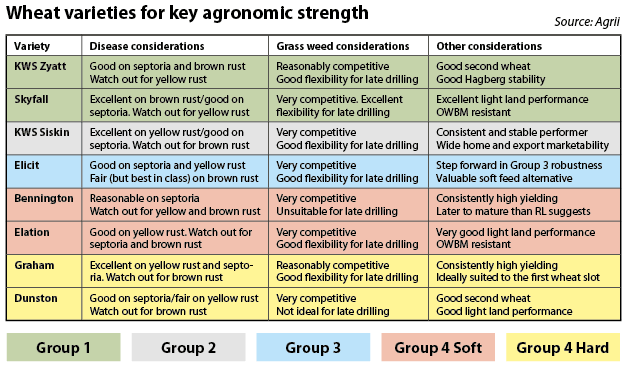Know your varieties’ key agronomic strengths
5th July 2018
Disease and grass weed management should be key drivers of wheat variety choice for many growers in 2018
Disease and grass weed management should be key drivers of wheat variety choice for many growers in 2018.
“Yield continues to be the main driver of wheat cost per tonne and all our research shows that agronomic strength is the best way of securing the most consistent yield at reasonable cost,” says Mr Barker.
“The highest levels of disease resistance and grass weed competitiveness, in particular, are equally important in giving management teams the flexibility to cope with increasing pressures of workloads and agrochemical resistance, not to mention today’s particular climatic variability,” he adds.
Evaluation
The latest agronomists’ Wheat Advisory List produced by Agrii from its comprehensive variety evaluation trials programme as a complement to the AHDB Recommended List, provides extended agronomic intelligence on no less than 33 varieties.
“Alongside the average multi-year RL disease resistance ratings, the most recent season’s disease resistance scores from our national variety trials provide up-to-date information on disease resilience,” he points out. “In many cases, these paint a very different picture of each variety’s current ability to combat yellow rust, brown rust and septoria.
“Of the established varieties, for instance, our work indicates nearly 80 per cent are at least one point lower in their actual brown rust resistance than the RL suggests. Around 40 per cent are one point or more lower in their yellow rust resistance and 30 per cent are a good point lower in their septoria resistance. And quite a few are two points adrift in their resistance scores.
“Updated from our trials as the season progresses to provide the most current guidance, this extra intelligence is really valuable in both choosing and managing varieties.
“Equally valuable in managing risk as far yellow rust is concerned are the variety groupings from the special Diversification Scheme developed and run for us by national disease expert, Dr Rosemary Bayles,” he adds.
“By linking variety resistance to ancestry information they identify varieties at particular risk of breakdown because of the genes they share with varieties susceptible to current rust races.
“Alongside the early warning of race changes provided from our national disease monitoring programme, these diversification groupings allow growers and their agronomists to choose wheat variety mixes for the least overall danger from yellow rust epidemics in the year ahead.”
Weed competition
Agrii’s variety evaluations at Stow Longa, with paired variety plots subjected to robust and compromised herbicide regimes each season, further allow research-based ratings for grass weed competitiveness to be provided as part of the Advisory List.
A total of 10 of the 33 varieties listed are identified as especially competitive, making them the most suitable for use in integrated agronomy programmes where black-grass, Italian ryegrass and bromes are already problematic or at risk of becoming so.
“When under pressure from high grass weed populations, our Stow Longa work has shown the most competitive varieties can lose less than half the yield of the least competitive, highlighting the value of variety choice in weed management,” says Mr Barker.
“Also valuable here is the guidance our Advisory List provides on variety suitability for late drilling. A total of 18 varieties are identified as suitable for sowing from early November to early January, with 9 rated as not ideal and 6 as unsuitable for the slot.”
Armed with this intelligence, Mr Barker sees a number of stand-out varieties across the range of wheat groups for those putting the priority on agronomy strength (see Table). As ever, though, choosing between them depends on growers’ particular agronomic risks and priorities.


